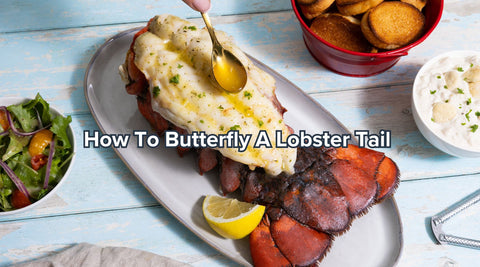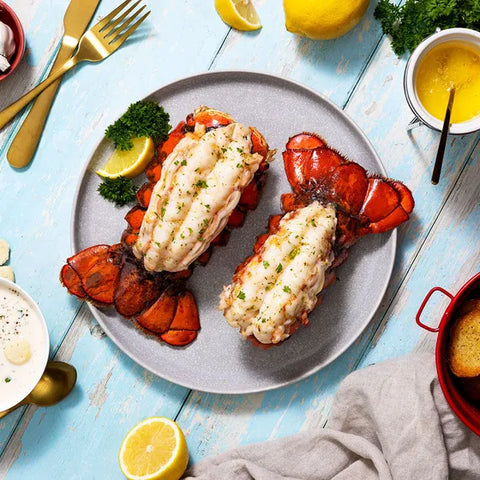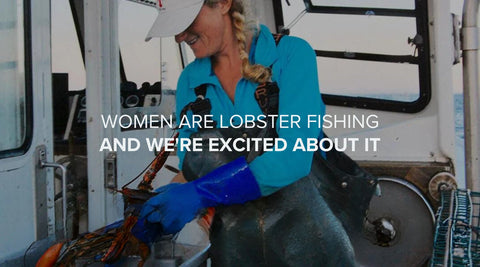
Nothing quite compares to a skillfully prepared steak, or a lobster cooked the day it’s caught. While the delicious taste speaks for itself, these foods deserve a little extra effort spent on presentation. The old adage is "don't judge a book by its cover," but appearance does matter, both with books and with premium dishes.
One of the ways to make lobster more aesthetically pleasing and easier to eat is to butterfly the tail. This method isn't just reserved for restaurants, you can do it in your own home! Through this lobster tail guide, you'll learn how to properly store lobster, the step-by-step instructions for butterflying lobster tails, and the benefits of this practice.
What Does It Mean to Butterfly a Lobster Tail?
Though you've probably eaten lobster before, you may not know what it means to butterfly a lobster tail. Basically, it involves cracking open the hard top shell so the meat underneath can come through. As it cooks, the lobster meat will start to puff up over the shell. High-class restaurants love this showy presentation.
Not only does butterflying a lobster tail make it look more attractive on your dinner plate, but it also helps the meat cook evenly. Lobster tails in the butterfly style can be baked, broiled, roasted, or grilled, which offers flexibility. Whether you're a barbecue master or you're more comfortable cooking with the oven, your lobster tail will come out beautiful and thoroughly heated. It may seem like a complex method of preparation, but with these instructions, you'll learn how to butterfly a lobster tail with ease.
Frozen vs. Fresh Lobster
First we will tackle the age-old question: which is better, frozen lobster or fresh? Though many people prefer purchasing a live lobster when they're cooking for themselves, each type has its pros and cons.
For instance, if you're an expert chef, you can utilize every part of a whole lobster if you buy it live. The different parts all have their own unique, delicious flavor, and you have the benefit of gathering the leftover shells and roe to make lobster stock. On top of that, ordering a fresh, live lobster is often cheaper than buying frozen tails.
With any sort of frozen food, but especially with seafood such as lobster, you never know how long the product has been sitting around at the grocery store. You run the risk of old, tough or freezer-burned lobster meat if you purchase it frozen. Not to mention, with frozen lobster tails you are more than likely unsure of their origin. Seeking out live lobster gives you a better chance of knowing where and how it was raised.
However, frozen lobster isn't always inferior. Sometimes, farmers raise lobsters in less than ideal conditions, crowded together in dirty, poorly maintained tanks. Various kinds of seafood are subject to fostering parasites, including lobster. Though many people say fresh lobster tastes superior to frozen, lobsters are frequently frozen right after they're caught, so it may still taste fresh when thawed and cooked.
Both frozen and fresh lobsters have their advantages and setbacks. If you have sensitive taste buds, you want to use every piece of a lobster rather than just the tail, or you want to save a little money, go with a live lobster instead of frozen.

Lobster Tails vs. Whole Lobster
Now you’re probably wondering, why do some people prefer lobster tails? After all, the entire lobster has tasty meat you could enjoy. Yet this preference extends from households to eating establishments, where you may see specials on lobster tails that are more expensive than whole lobsters! It doesn’t seem to make sense.
The truth is, the lobster tail is simple to prepare and highly satisfying. While buying a whole lobster may sound like less hassle on the surface, the cooking process creates a lot more mess. By the time you’re finished, your meal will be getting cold – and lobster isn’t something you want to pop in the microwave! Let’s face it: tails by themselves don’t require as much effort. Not to mention, if you’re squeamish, working with a live lobster in your kitchen may be too much for you to handle.
Even if you’re able to overcome that hurdle for the allure of a more substantial meal, you’ll just be disappointed. Most of the meat in a lobster’s body isn’t the greatest quality; the claws are good, but the best meat by far is in the tail. There’s a much larger quantity of it, and it’s incredibly delicious. On top of that, while other parts of a lobster are hard to deconstruct, you can easily pull the meat out of the tail with a fork. As you might imagine, butterflying lobster tails simplifies this even more!
Storing Lobster Tails
Maybe your lobster is going to function as a side dish instead of the main course, or you're hosting a party and you want a little bit of lobster for everyone. In that case, you should buy lobster tails on their own. They can be found in the seafood section or freezer cases of your local grocery store, or you can purchase lobster tails or meat from online suppliers such as Maine Lobster Now. Look for the most substantial, high-quality tails you can get.
Lobster tails should be fresh and raw for cooking. When you bring home frozen tails, thaw them in the refrigerator before you do anything with them. Much like live lobster, a lobster tail will keep in the refrigerator for 1-2 days, if it’s kept in a tightly covered container. However, if you want to save it for a special occasion in the future, you can place the tail in a heavy-duty freezer bag or airtight plastic container and put it in your freezer. Frozen, it will keep for up to 6 months.
Learn How to Butterfly a Lobster Tail

As we mentioned, before you begin the process of butterflying or cooking, the lobster tail should be at the right temperature. If it was just inside the freezer, make sure it defrosts completely so you can use it. In terms of cutting implements, you'll need kitchen shears to get through the lobster's thick shell.
- Cut Open the Shell
Place the lobster tail shell side up on the table. Line up the bottom blade right under the shell, not within the meat itself. Hold the tail with one hand while you slowly cut down the center of the shell with the other. Continue cutting the upper-shell all the way to the base of the tail. Do not touch the tail fan or under-shell, they should be left attached and intact. If you don't own kitchen shears, you'll also be able to cut through the shell with a sharp knife, but be exceptionally careful so you don't slice through the bottom of the shell.
- Pry Apart the Shell
The next step is opening the shell. Grab each side of the lobster shell with your thumbs and fingers to further spread the halves apart. You'll need to be gentle when doing so, because you want to pry away the shell so it's loose, but keep the back of the meat connected to the under-shell. After you've done this, the meat will be clearly visible.
- Pull Out the Meat
Now you're going to separate the meat. Press down with your thumbs and push the lobster meat apart with the shell halves. Then carefully tug the meat so it comes off the bottom shell, still keeping the back attached near the tail fan. Pull the meat upward, lay it on top of the shell, and squeeze the shell halves close together beneath it. Make a small slit in the top of the meat so you can continue to fold it over the shell.
- Marinade and Skewer the Tail
Professionals recommend broiling your lobster tail after you butterfly it, but as we said above, baking, roasting, or grilling are solid choices as well. If you want to cut a few extra slits in the meat for presentation, go ahead. Otherwise, the lobster tail is ready to be brushed with butter and seasoned. Drizzle marinade over the tail before cooking, and consider using a wooden or metal skewer — inserted lengthwise — to keep the meat flat.
- Cook the Lobster Tail
The heat from the stove or barbecue grill will cause the meat to puff up even further over the shell halves. About halfway through cooking, you can take out the lobster tail and baste it with more marinade to heighten the flavor. If you're grilling the tail, the internal temperature of the meat should reach 135°F, while baked tails should be between 140 and 145°F. After cooking is complete, you can remove the skewer and the tail will remain flat.
Why Butterfly Lobster Tails?
The process of butterflying lobster tails is easy, as long as you follow the directions closely, and preparing the tail this way has numerous advantages. Marinating in advance is simple, and basting midway through cooking is a breeze. The meat will retain its own juices, yet fully absorb your marinade, and it will also soak in the smoke from grilling or complementary flavors from broiling, roasting, or baking.
Monitoring the meat in a butterflied lobster tail is no trouble at all. As it cooks, you'll be able to check the temperature and watch it turn a beautiful golden color. When you take it out of the pan or off the grill, the meat will stay flat and easy to serve for your family or friends. They'll come away impressed, not only with the taste but with the presentation itself.
Serving Your Butterflied Lobster Tail
It's completely okay if all you want to cover your cooked lobster tail in is melted butter. There are easy ways to switch it up a little, however. Many people will prepare garlic butter to go with their lobster, using paprika, parsley and two full cloves of garlic. You could sprinkle Cajun spices on top, give the tail a fresh flavor with lemon juice or wedges or brush it with herbs and butter. For the truly daring, use a bit of chili seasoning! Plenty of items on your spice rack will complement lobster tails — just be careful not to stray too far into left field.
When pairing side dishes or desserts with your lobster tail, the key is to find something that will play up the flavors in the lobster without overpowering them. For instance, if you want soup or salad with your meal, go with butternut squash soup, corn chowder, cucumber salad, or Caprese salad. Wild rice, pesto linguine, cheddar biscuits, and Italian bread also make for delicious but understated sides.
Lobster tails are the perfect entree for summer events. A New England favorite, they are best served with a shrimp appetizer or coleslaw on the side. Roasted broccoli, asparagus, corn on the cob or other grilled veggies work well with lobster meat thanks to the contrasting flavor they bring to the table.
Dessert shouldn't be too heavy, after the rich lobster you just polished off. Offer champagne or sparkling cider to drink, and pile on the fresh fruit or sherbet topped with berries. If you want something a bit sweeter, go with strawberry shortcake, tiramisu or some sort of sponge cake.
Preparing Lobster is a Fun Experience
Just like baking or putting together kabobs, butterflying lobster tails is something enjoyable to try with your family members or significant other. It's a chance to bond over a shared experience, and you'll be learning a new kitchen trick in the process. You'll feel like a chef in a five-star restaurant preparing the lobster and indulging in the delectable finished product.
If you're hosting a large party or helping entertain several guests, it's simple to butterfly anywhere from one to twelve lobster tails in advance and store them away. They can be prepared up to six hours before an event, and they'll cook quickly so your guests won't be waiting around hungry for long! To make them less complicated for visitors to figure out, spread the shell open a little more so they can easily access the meat.
Where You Get Your Lobster Matters
We hope that these tips on how to butterfly a lobster tail have made this cooking idea feel a little more approachable. Just because restaurants are known for it doesn't mean it can't be done at home! You just need the right tools, the steps explained in simple terms, and the best quality lobster tail available.
No matter what occasion the lobster is for, it's important to purchase it from a reputable business. That way you'll know it's in top condition and at its freshest. Otherwise, your cooking could turn out tasting bad through no fault of your own. Don’t fall for prices that are unbelievably low, because as the saying goes “you get what you pay for.” Avoid lobster tails that have turned gray, have yellowing meat or discoloration such as black spots. Unfortunately, many sellers out there will try to rip you off, so you need to find a trustworthy source.




